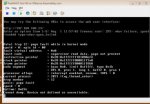A friend is looking for a storage solution for his growing photography business. He initially needs around 4TB of space, but wants room to expand. It's come down to either a Drobo FS w/ 5x2TB drives (~$1100) or a HP Microserver running FreeNAS w/ 4x3TB drives (also ~$1100), either way giving him roughly 5.44TB of storage. In either case, he wants the ability for two drives to fail before he has to worry about losing data (e.g. raidz2).
The issue I'm currently stuck on is extendability. Assuming the 5-bay Drobo FS will accept 3TB drives, it maxes out at 8.16TB. But with the Microserver, he can add a RAID/HBA card and an external SAS cage with, say, four more drives. The problem is the classic non-expandability of a ZFS volume. If he adds another raidz2 array with four disks, that'll double his storage to 10.88TB. But if he rebuilds the whole thing as a single eight drive raidz2 array, he'll get 16.32TB out of it -- quite a difference!
So here's my imperfect, but potentially acceptable plan: When it's time to expand, pull the two spare drives from the original array and build the new eight disk array, but initially supply only six drives (four new drives, plus the two spares from the original array). Then copy the data from the original array to the new one, and once the data is on the new array, add the remaining two drives from the original array to complete the 8x3TB raidz2 array.
Here are my questions: 1) Will the original array still let me read data from it if two of the disks are gone, or will it insist on being repaired first? 2) Will I be able to create the new array without all eight disks physically present, perhaps using /dev/null (or something) as the two extra disks? 3) Even if I can create it, will I be able to mount it RW to copy the old data onto it? 4) Will the CPU in the Microserver (AMD NEO N36L @ 1.3 GHz) be able to handle eight 3TB drives? There will be 8GB of RAM installed.
Thanks for any suggestions!
The issue I'm currently stuck on is extendability. Assuming the 5-bay Drobo FS will accept 3TB drives, it maxes out at 8.16TB. But with the Microserver, he can add a RAID/HBA card and an external SAS cage with, say, four more drives. The problem is the classic non-expandability of a ZFS volume. If he adds another raidz2 array with four disks, that'll double his storage to 10.88TB. But if he rebuilds the whole thing as a single eight drive raidz2 array, he'll get 16.32TB out of it -- quite a difference!
So here's my imperfect, but potentially acceptable plan: When it's time to expand, pull the two spare drives from the original array and build the new eight disk array, but initially supply only six drives (four new drives, plus the two spares from the original array). Then copy the data from the original array to the new one, and once the data is on the new array, add the remaining two drives from the original array to complete the 8x3TB raidz2 array.
Here are my questions: 1) Will the original array still let me read data from it if two of the disks are gone, or will it insist on being repaired first? 2) Will I be able to create the new array without all eight disks physically present, perhaps using /dev/null (or something) as the two extra disks? 3) Even if I can create it, will I be able to mount it RW to copy the old data onto it? 4) Will the CPU in the Microserver (AMD NEO N36L @ 1.3 GHz) be able to handle eight 3TB drives? There will be 8GB of RAM installed.
Thanks for any suggestions!


